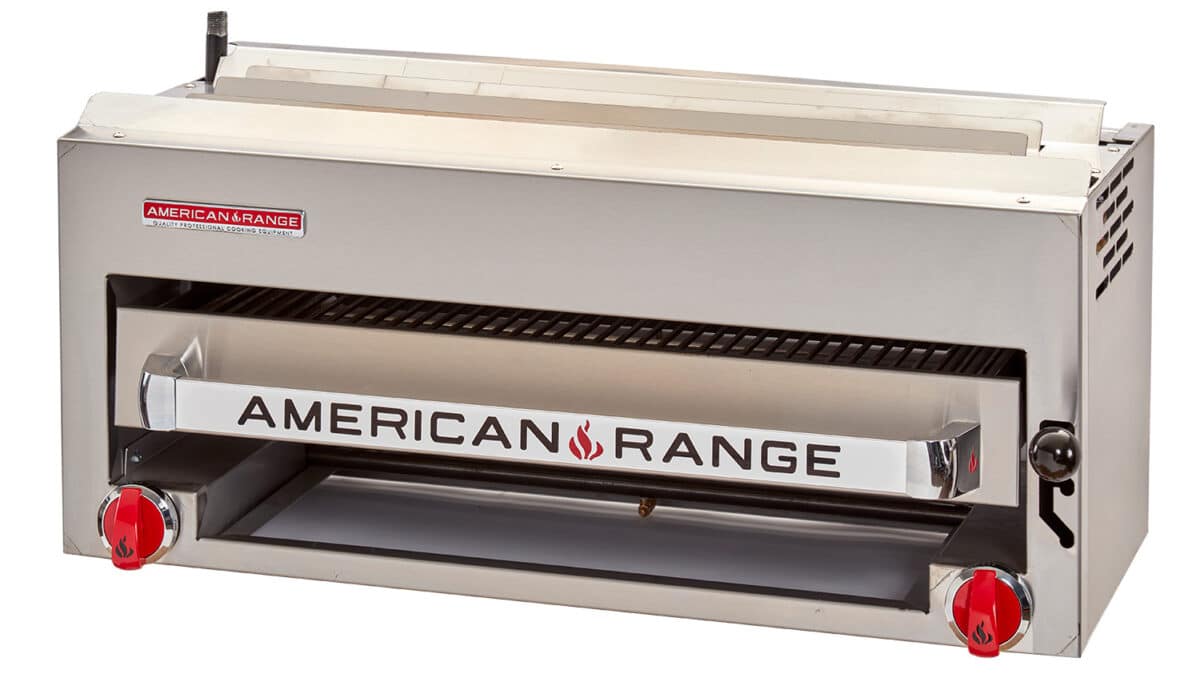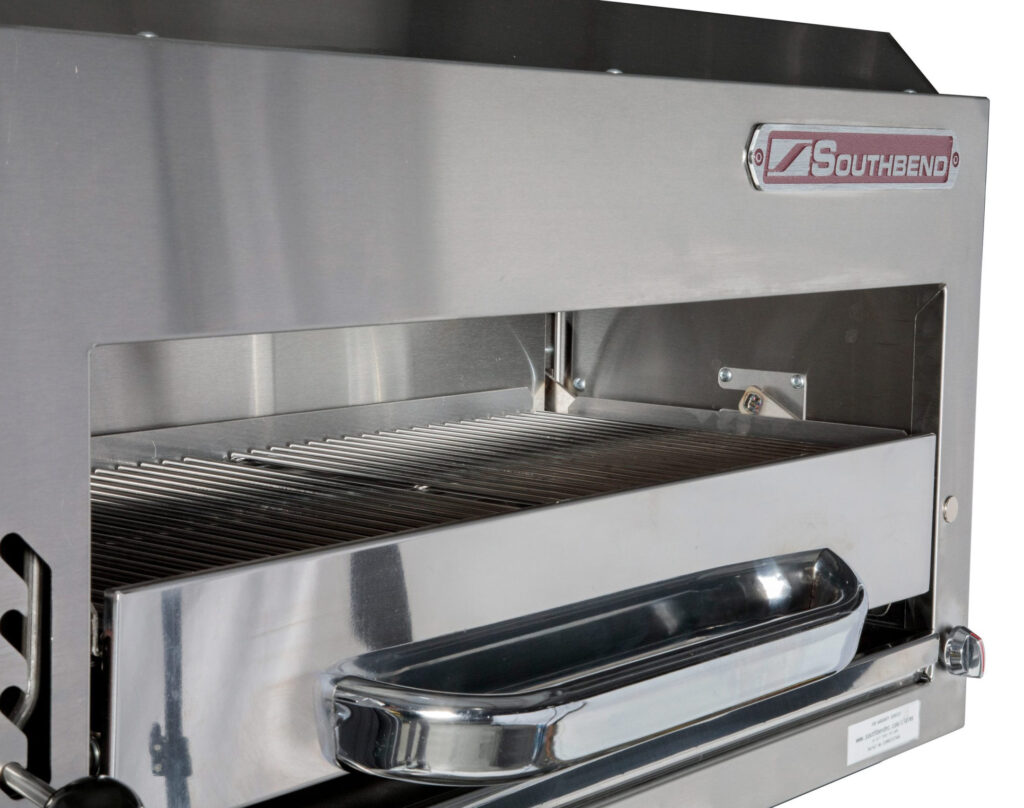What is a Salamander in Cooking?

(David Attenborough voice): The elusive salamander roams the earth in many colors and is associated with magic and folklore …
Oops, wrong channel.
The modern-day kitchen is not exactly as zen as the burbling brooks many salamanders (the animals) call home. But a salamander in the kitchen is an equally magical creation that can elevate your culinary product and calm your nerves as you watch a perfectly cooked and crisped-just-right chicken dish, potato, or steak emerge from its radiant glow. It adds that little special something that keeps diners coming back.
We’ve covered what it is not, but … what is it?
What is a Salamander? (In Cooking)
A salamander is designed to cook hot and cook fast. So what, you say, that’s what an oven is for, or a microwave, or an oven broiler. That’s the thing — a salamander does what those do much faster and better, and can’t be beat.
A salamander’s primary functions are to broil, brown, finish, grill or toast. It can sit independently from your oven altogether or be mounted above for ease of transferring a dish that needs a final finishing touch. If you think of the professional kitchen like a Swiss army knife of helpful tools to get your orders out and to keep your customers raving, the salamander is one of those that, once you have it, you won’t want to live without.
Features and Capabilities of a Cooking Salamander

A salamander contains a grilling rack and a small oven that looks a bit like a toaster oven in proportions. Inside the salamander is a heat source. On the sides of a salamander, you will have controls to change the heat, sometimes with different temperatures on different sides. Some salamanders also come with a rotisserie feature to further jazz up your salamander cooking repertoire.
Some salamanders allow you to lower the heat source, contained in what looks like a hood, over a stationary grill (an electric salamander, for example). Flip them on for as little as 10 seconds and have your food browned, or easily push your pan in for a little extra heat.
Since salamanders can be such a subtle but effective difference-maker in the little things — like getting the perfect crust on a steak, or browning the top of a dish — investigating which model you want and investing in the one that really does what you need the way you need it is worth the time. A salmanader will help you channel your passion about food to its height — giving your steak the perfect crust, giving a nutty caramelized flavor to potatoes au gratin, or getting the skin on your chicken so crispy that you become the biggest name in town. Bringing together the best techniques with the finest equipment to pull them off is what Eleven36 is all about. We aren’t here to sell you something you will be frustrated with and say goodbye — we are foodies who want to help you figure out how to make the perfect dish the right way every time.
Salamander Cooking Types Explained
Salamanders distinguish themselves as being either mountable and near an oven, or smaller units that can sit on a counter (often near orders going out — in that case, you can use them to keep food warm). Ceramic burners are common and provide even, very high heat. Infrared or quartz heat in a salamander is more expensive but also more intense, and can heat up food even faster, providing an especially delicate touch (or more consistency if your establishment is going to lean on the salamander a lot). There are also salamanders that rely on gas or electric, but those heat up a little more slowly. Still, they can be incredibly effective and useful.
How you want to use a salamander to spice up your menu will dictate what type you want to get. If you are more interested in keeping food hot, then you will want a countertop salamander. If you want to be able to pull dishes out and straight into the salamander for a finishing touch, a mounted model may be better, although it just depends on how much table space you have.
How to Choose the Right Salamander
There are many, many salamanders on the market, and you might be thinking, for the price of some of the higher-end salamanders, I could fill my kitchen with these appliances (or maybe even enough rare amphibians to catch David Attenborough’s eye!)
The reality is that some of the models on the market do not have the longevity or the heat you need to create dishes with the consistency you would want. And certain features, like pass-through construction (one person puts in the dish on one end, another takes it out on the other) are worth the investment.
It comes back to menu (doesn’t it always in the food service business?). In preparing dishes that thrive under high heat, like steak or chicken, or even veggies and casseroles, a half-second can make the difference between perfect or overdone. Investing in a serious salamander with precise and multiple temperature controls is worth it if that is your bread and butter. If you are looking to make nachos or keep food warm, then a smaller unit with less intense heat is probably fine. You can also look into units with rotisserie options to perfectly cook meat on a spit. Understanding your needs and providing you with the precise version of this tool that meets them is what Eleven36 is all about.
Salamander Cooking Techniques
As mentioned above, salamanders broil, brown, toast and finish meals. What meals are they best at? Well, think of steak (Pittsburgh blue or otherwise!). Or dessert! (MMM, crème brûlée). Or think about creamy gratin potatoes with the perfect crust. Or the ultimate un-soggy pub nachos.
OK, we get it, we made you hungry — we’ll wait for you to get back …
Maintenance and Care of Salamander Appliances
Much like a toaster oven, with a salamander you are going to want to clean the tray beneath it that catches crumbs and oil (pro tip: line the tray with foil for ease). And you will also want to make sure the rotisserie or grill is clean if you are placing anything on there directly (or even if not; liquids often somehow find their way to drip out of a pot or pan). For the sake of your pots and pans, make sure you don’t stick any in the salamander that can’t handle the heat. Keep things clean (and wipe down to dry) and lubricate any parts, and your salamander should last a long time.
A salamander is one of those kitchen appliances that, once you have it, you realize you can’t live without. It’s a shortcut to kitchen greatness and puts a dash of deliciousness on everything it touches — in just seconds! At Eleven36, we will help you find a salamander that you can fall in love with and build a menu around — one that is worth the money and that will be there for you for a long time. Even David Attenborough would gush about that.
